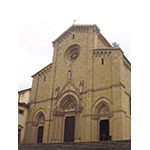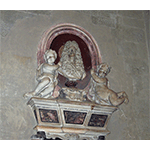Arezzo Cathedral
The construction of the Cathedral of Arezzo (San Pietro Maggiore) began around 1278, but spanned various epochs, indeed lasting until the early 16th century. The facade which had remained unfinished in the 15th century, was rebuilt in the 20th century in the neo-Gothic style on a design by Dante Viviani. Three stone measures of reference dating to the 13th century are walled on the south wall. The interior is a fine example of Gothic architecture, and abounds in works of art of great value.
Left of the entrance, near the sumptuous Chapel of the Madonna del Comforto, the funeral monument to Arezzo scientist Francesco Redi bears his family coat of arms. A bust of the scientist sits above the coffin.
The affairs around Redi’s body remain enigmatic to this day. He died after an apoplectic fit during the night of March 1, 1697 in Pisa, where he had gone with the Medici court. After an autopsy ordered by Grand Duke Cosimo III himself, his body was embalmed. The body was then moved to Arezzo and buried with great solemnity in the Church of San Francesco, in compliance with his testamentary wishes. In 1812, during the Napoleonic municipality, there was talk of transforming the church of San Francesco into a theatre. Worried for the destiny of the body, Redi’s great grandson Francesco Saverio had the funeral monument transferred to the Cathedral, but thereafter all trace of the body has been lost. Despite painstaking research conducted by scholars of local history, it is today impossible to say just where the mortal remains of the Arezzo doctor lie.
****************************
Texts by Graziano Magrini
English translation by Victor Beard
Last update 22/feb/2008





